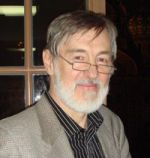|
 Petr P. Chobitko was born in Kiev, in 1946. Petr P. Chobitko was born in Kiev, in 1946.
After graduation from the T.G. Shevchenko Republican Artistic School, Petr Chobit’ko enters the Kiev National Artistic College in 1965. His creative work started from the second year in the college – he took part in the Republican Exhibition of Young Artists. In 1966, he was transferred to the Tallinn National Artistic College of the Estonian SSR, School of Graphic Arts, and soon became a pupil of a well-known tefacher, master of calligraphy and manuscripts – Paul Lukhtein.
While studying in Tallinn, he took part in the Republican Exhibition of Estonian Poster (1968), at which he received the 1st degree Diploma. The same diploma was awarded for his work at the Baltic Triennale in Vilnius (1970).
In summer 1969, he had internship in the Leipzig High School of Graphics, with Albert Kapr – a well-known font and calligraphy professor.
The future artist was attracted by anything that has to do with font – a book, a poster, industrial graphic work – and also font book-plate. He began making book-plates in different graphic techniques when in college. Petr Chobitko’s book-plates were displayed in book-plate exhibitions many times. Well-known artists, culture figures, collectors and museums ordered font book-plates to him. The calligraphic monogram played the major part in the artist’s book-plates.
In 1971, under the guidance of Professor P. Lukhtein, he made his graduation work with excellent mark. The paper included posters, font and applied graphic (logo, booklet, set of stamps). In the same year, he was invited to position of Senior Teacher at the Kiev National College School of Graphics (at present, the National Academy of Arts), in which, for a number of years, he successfully combined teaching of applied graphics, font and basics of composition with scientific and creative work.
For a number of years, Petr Chobitko held creative workshops in font art and composition for young artists in creative houses (Sednev, Senezh, Dzintari).
Since 1966, he took part in republican, regional and all-Union exhibitions and contests of posters, font graphics, book and book binders, which enabled him to become a member of the USSR Union of Artists in 1974.
As a participant in international Biennales, the artist went to creative business trips abroad, took part in republican and international symposiums and conferences in font and book art. 1974/1976, in co-authorship with his colleague from Tallinn, V.A. Smirnov, designed and decorated the Museum of Partisan Glory in Yaremcha (Near-Carpathian Mountains).
In 1983/1986, he performed a major order to decorate the Republican Museum of Literature in Kiev, with a group of his pupils.
In 1985, to the anniversary of First Printer Ivan Fedorov, he arranged for the report anniversary exhibition entitled Font and Calligraphy, at which work of students and the master itself were displayed. This was a sort of a report on a 15-year teaching and creative work of an artist. In 1986, after the Chernobyl tragedy, the artist performs a responsible order of the Medicine Museum: honorary Diplomas and medals for Dr. Gail and businessman Hammer.
In 1987, due to poor health, the artist went to the Mountain Altai. There he continued his creative and teaching work.
In 1992, he acted as the arranger of the group exhibition of artists of the district, which was displayed in Anokhin Republican Museum (Gorno-Altaisk).
In 1993, he established the school of applied arts on shore the Teletskoye Lake, in the settlement of Iogach. New conditions gave new options to the artist to feel and disclose himself in other types of creative work – art, interior, and landscape design. Being engaged in the Cedar Taiga Museum Decoration Project, he took a cutter in his hands for the first time for wood-carving, devoting much time to this type of art.
While working on the museum exhibition, observing and studying the environment and the form of heartless and pragmatic interaction of a human being with it, he became a proponent of environment conservation. He developed and proposed the program for spiritual and cultural revival of the Near-Teletskoye Lake Region, for recovery of conventional crafts, environmental training of young generation at schools. This program was adopted in 1991, at the International Symposium in Gorno-Altaisk.
In 1997, as the school of applied arts became more and more popular, and the number of those willing to study there increased year by year, in his capacity of the school director, he ensured allocation of a new premise to teach ceramics, artistic leather processing, decorative painting and wood-carving to more children.
In 2000, he moved to St. Petersburg at the invitation of the Director of the School of Folk Arts (Empress Alexandra Fedorovna School), and taught calligraphy and drawing in that school for two years.
In 2001, he was invited to part-time teaching to the Chair of SKG at St. Petersburg National Artistic and Industrial Academy.
Since 2002, he has been a staff professor of font and calligraphy in the Chair of SKG and also taught font at other chairs of St. Petersburg National Artistic and Industrial Academy, such as the Chair of Ceramics, Glass, Metal, Design.
Since 2005, he taught the school of calligraphy, according to his author program.
Since 2007, he has taught in the School of Graphics, St. Petersburg Academic College of Art, Sculpture and Architecture (I.E. Repin College).
Besides teaching, he continues scientific and educational work, takes part in conferences, holds workshops, lectures and master classes in different educational institutions of Russia.
|

